
| The
Green Dragon Tavern, Headquarters of the Sons of Liberty |
Boston
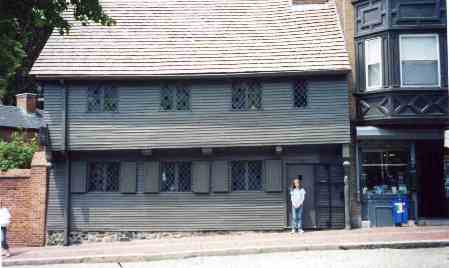
| The Paul Revere Home, built 1658, oldest remaining house in Boston |
| Canoeing | Skiing | Bicycling | Forum |

|
Boston |

|
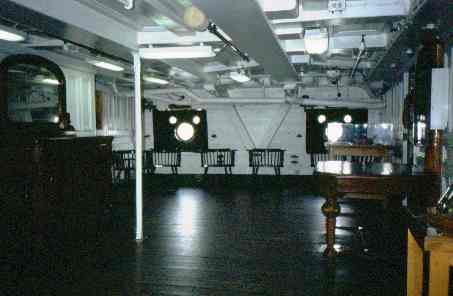 |
Getting into Boston from Salem is fairly easy. Assuming you
stopped at Saugus, as you leave the Iron Works, turn West on Main Street
and then South on Route 1. As the Boston skyline looms across the water,
you'll cross the Mystic River over the Tobin Bridge. That will bring you
onto Chelsea Street, with the sails of the USS Constitution to your left.
Now be careful. Do not drift over to the left lane. At the Residence Inn,
you will see turn left turn signs pointing across the Charlestown Bridge,
but ignore those and keep going one more block to the Zakim Bunker Hill
Bridge. This is the fancy new suspension bridge. Coming off this bridge,
turn right on Causeway Street. Look for the Boston Garden / Fleet Center
to your right. To your left, pass Canal Street, then turn left onto Friend
Street. You will see the entrance to the Shawmut Hotel to your right.
|
| You've flanked Boston to the South at Plymouth and to the North at Salem, so now it's time to experience the city itself. Organizing the trip in this way makes sense because it places everything in chronological order. The Mayflower arrived at Plymouth in 1620, and Roger Conant and his Puritans founded Salem in 1626. Boston had the better harbor, but was a swamp infested with clouds of mosquitos. Conant put it succinctly : "Some day this will be the best port on the entire coast," he predicted, "but first somebody will have to figure out a way to drain the swamp and drive off the mosquitos, and that won't be in my lifetime." Sure enough, once Boston was settled, it grew rapidly and became the "Shining City On The Hill" everyone predicted. | 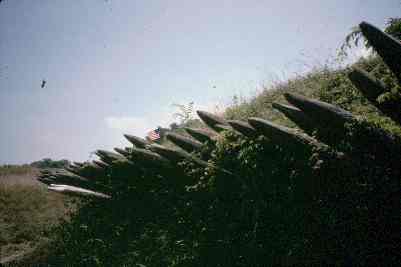
|
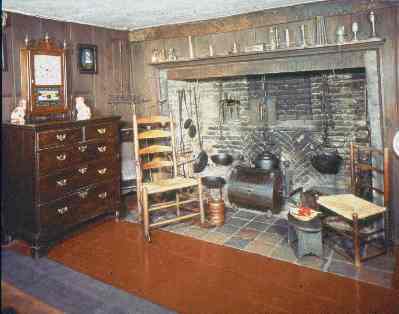 |
The Boston you see today is not the same Boston of Revolutionary War days. The waterfront is different at each point. In some places, the coastline has been dug out and evened. In others, water has been filled in to make room for more building. For example, Faneuil Hall was on the water. Sam and John Adams, Paul Revere, John Hancock and Dr. Warren wrote of cargo being unloaded. Indeed, Crispus Attucks was loading cargo from a ship into one of the back recesses of Fanueil Hall when the British came chasing several small boys down the alley and he intervened, igniting the Boston Massacre. Today, the water is a block away. Little Italy was a peninsula, jutting out into the harbor. Today, the waterline has been squared off so Little Italy is just a corner of downtown. When you visit The Old Statehouse, make it a point to walk out on the East Porch and look down State Street. Where the Marriott Custom House is was the location for John Hancock's Wharf. Today, the water can still be seen from that porch, but it's two blocks further away. In 1775, no bridges had been built in any direction, because they would have interfered with sail masts, and the engineering did not yet exist to build a high bridge or drawbridge. So when Paul Revere crossed the Charles River, he had to row, and when the British marched, they had to first ferry the entire force, including officers' horses, across in Dories |
Bostonians today are fanatics about their history, and they
can take to the streets pretty quick if they think one of their politicians
or businessmen is threatening a historical site. This is why so many of
the original buildings are still standing. But it was not always this way.
All of the city's historical passion stems from one event, which they still
talk about as if it happened last week, even though no one now alive was
there. That was the destruction of John Hancock's house. The house stood
on Beacon Street, along the top of Boston Common, next to the New State
House. The Daughters of the American Revolution had made it clear they did
not want it touched, but in the middle of the night the city bulldozed it.
The DAR went ballistic. They filed lawsuits, roused massive public demonstrations
and waged a media campaign. Every politician with any connection to the
action was voted out. Laws were passed. The National Historic Registry was
created. Prior to that the DAR had been a rather benign organization of
white gloved little old ladies. The loss of their beloved Hancock House
galvanized them. They realized the 20th Century had brought a new breed
of politicians and developers with no respect for the past, men who could
not be trusted, men who would ignore laws and traditions and their own promises.
The DAR became a radical, aggressive defender of the nation's founding history.
They raised the money to hire lawyers good enough to take people to court
and make them regret any disregard for that history. Today, the DAR is a
sophisticated, relentless force in Boston, all of Massachusetts, and anywhere
else there is Revolutionary War history to preserve. They have fund raising
specialists who have built a huge war chest. So the fact that you can walk
the Freedom Trail today in the very shadow of 21st Centuiry skyscrapers,
that you can hike the same trail Paul Revere rode that night, and you can
see Lexington Green or The Old North Bridge, is a tribute to them.
|
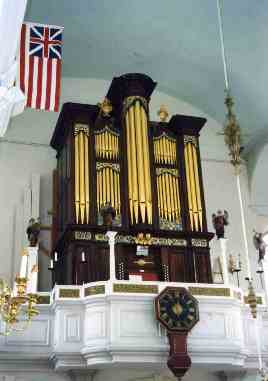 |
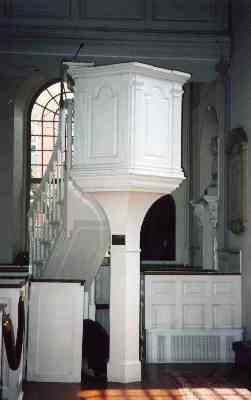 |
Understand two facts up front : l. There is no camping in Boston and all lodging is expensive. We can guide you to the most reasonable hotels, but there are no Motel 6s in Boston. 2. You cannot see historical Boston except on foot. You cannot drive. Many of the old streets are too narrow for vans or SUVs, and even if you could get down one, there would be absolutely no place to park. Camping someplace out in the suburbs and driving in each day is unworkable. We've tried it. Forget it. Assuming you can find a parking space, which is questionable, you will spend enough per day parking to pay for the hotel room. We've also tried staying in the suburbs, driving to the nearest Boston Transit (MBTA) stop, and riding in. That doesn't work, either. You use up too much of your day at either end waiting for the next train. In either case, you're spending valuable time in transit from the suburbs into the city. And there is the final factor of Driving In Boston. In no other city is driving quite the experience it is here. Everyone goes 70 mph all the time. If you slow down to, say, 60, 300 drivers roll their windows down, shake their fists in the air, and curse at you. Proper etiquette here is to speed up on yellow and go ahead through the intersection if the light is just turning red while you are in the crosswalk. And Boston is the American capital of a British device called The Rotary. This replaces stop signs and traffic lights with a circular multilaned intersection where everyone continues to drive 70 mph as they speed around, change lanes, then spin off in various directions. One of the best recreations in Boston is finding a good bench or wall, sitting with a soft drink, and watching the Rotary action for an hour or so. It is great training for NASCAR and Demolition Derbies but not a good experience with a van full of students or a car with your family. So just budget ahead, raise the funds, and stay in the city. Don't expect to park at the hotel. Even those who have their own parking structures have them three blocks away. But the parking structures have 24 hour security. Almost all Boston hotels serve complementary breakfasts.
|
You've done some walking in Plymouth and Salem, and we suggested
some trails on Cape Anne. But in Boston you're going to do some serious
hiking. Each person needs a daypack or buttpack, water bottle, snacks, change
of socks, and talcum powder. A rain garment wouldn't hurt, either. Wear
sunglasses and a brimmed hat. Apply sunblock. You'll see ads for trolleys,
buses and amphibious vehicles. They are useful in other parts of the city
: Beacon Hill, The Back Bay, Cambridge, etc. But those vehicles can't squeeze
through the historical streets, either. So figure on an eight mile Freedom
Trail hike and a three mile North Side hike. Fortunately, the Freedom Trail
is a famous walkway, and sidewalk vendors, machines and groceries along
the way sell snacks and drinks, sandwiches, wraps, fruit, cheese and salads
that you can eat while walking.
|
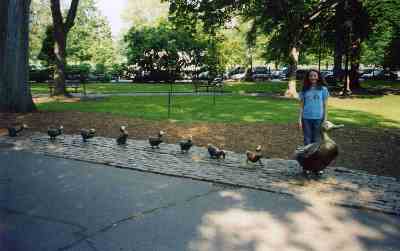 |
|
|||
|